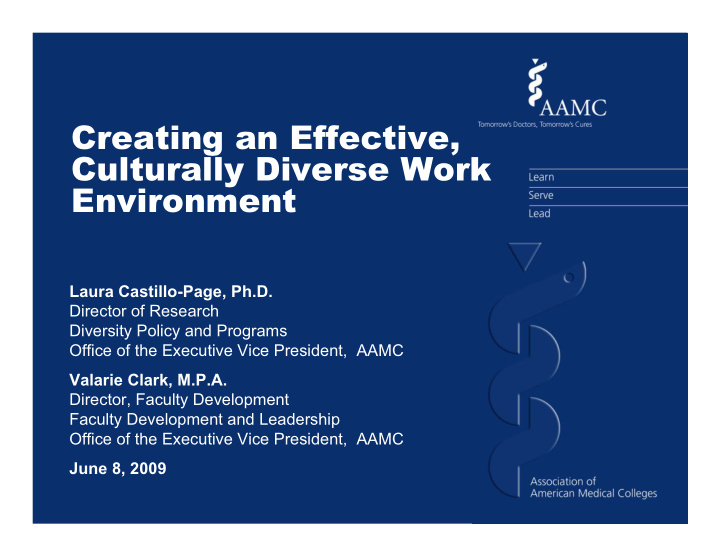



Creating an Effective, Culturally Diverse Work Environment Laura Castillo-Page, Ph.D. Director of Research Diversity Policy and Programs Office of the Executive Vice President, AAMC Valarie Clark, M.P.A. Director, Faculty Development Faculty Development and Leadership Office of the Executive Vice President, AAMC June 8, 2009
Goals For Today • Define diversity and organizational culture • Highlight the benefits of diversity • Identify barriers and challenges to organizational change • Commitment to success
Defining Diversity Cultivating the seeds of diversity means recognizing the value of expanding our recognition of traditional and emerging identities from solely a focus on race/ethnicity and gender to considerations of:
Importance of Diversity
Positive Returns
Positive Returns
Positive Returns
Positive Returns
Positive Returns
Educational Benefits of a Diverse Faculty “A diverse faculty could affect teaching and learning in a positive fashion…could reach all types of learners and provide respect for needs of diverse learners and respect for diverse scholarship, promote student creativity in scholarship, improve accessibility, provide flexibility such as responding to ‘teachable moments,’ and improve strategies of teaching.”
Benefits of a Diverse Faculty • Faculty diversity and leadership is necessary to realize the full benefits of diversity (Milem, 2001) • Increasing structural diversity is an important first step but when considered without other efforts can adversely affect the experience of students (Hurtado et al., 1998, 1999; Chang, 1999)
Barriers to Increasing a Diverse Faculty
Dr. Edgar Schein’s definition of Culture “A pattern of shared basic assumptions that the group learned as it solved it’s problems of external adaptation and internal integration, that has worked well enough to be considered valid and, therefore, to be taught to new member as the correct way to perceive, and feel in relation to those problems.” Source: “Organizational Cultural and Leadership”, Edgar H. Shein
How Do We Begin? Bottom Up Top Down Crisis (Demands us to explore solutions)
The Old Academic Culture Versus The New Academic Culture Old Academic Culture New Academic Culture • Autonomy • Mutual goal-setting and shared accountability • Independence • Interdependence across individuals and systems • Individuality • Group process and consensus • Narrow, focused • Professional diversity and professional pathways adaptation • Predictable career trajectory • Creative pathways that balance service and scholarship
How Do We Access the Current Picture? • Climate survey • Focus Groups • Promotion and Tenure Policies • Salary Equity • Talent Management • Exit Surveys
On the Right Track!
Process of Ambitious Work • Start slow • Identify group or individual as responsible party • Tap into all levels of the organization
The Elephant in the Room 1. What do we tell others about us ? 2. What do we tell ourselves , about ourselves? 3. What do we talk about only behind closed doors? 4. What don’t we talk about, but should? Source: Jim Herman, M.D. and John Neely, M.D.
Commitment to Success • Set goals (not about the #s) • Create a platform to share good and not so good • Communicate consistent messages often
Questions? Thank you!
Recommend
More recommend